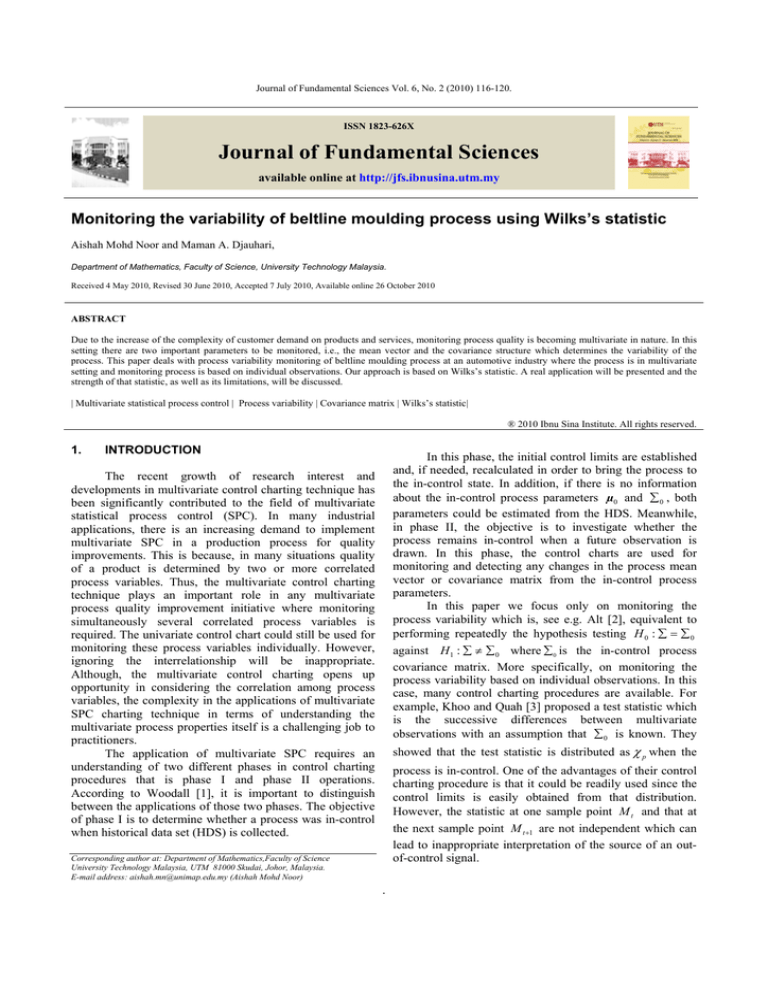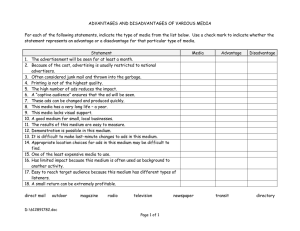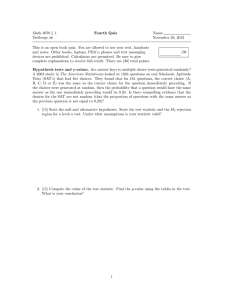
Journal of Fundamental Sciences Vol. 6, No. 2 (2010) 116-120.
ISSN 1823-626X
Journal of Fundamental Sciences
available online at http://jfs.ibnusina.utm.my
Monitoring the variability of beltline moulding process using Wilks’s statistic
Aishah Mohd Noor and Maman A. Djauhari,
Department of Mathematics, Faculty of Science, University Technology Malaysia.
Received 4 May 2010, Revised 30 June 2010, Accepted 7 July 2010, Available online 26 October 2010
ABSTRACT
Due to the increase of the complexity of customer demand on products and services, monitoring process quality is becoming multivariate in nature. In this
setting there are two important parameters to be monitored, i.e., the mean vector and the covariance structure which determines the variability of the
process. This paper deals with process variability monitoring of beltline moulding process at an automotive industry where the process is in multivariate
setting and monitoring process is based on individual observations. Our approach is based on Wilks’s statistic. A real application will be presented and the
strength of that statistic, as well as its limitations, will be discussed.
| Multivariate statistical process control | Process variability | Covariance matrix | Wilks’s statistic|
® 2010 Ibnu Sina Institute. All rights reserved.
1.
INTRODUCTION
In this phase, the initial control limits are established
and, if needed, recalculated in order to bring the process to
the in-control state. In addition, if there is no information
about the in-control process parameters µ0 and ∑ 0 , both
parameters could be estimated from the HDS. Meanwhile,
in phase II, the objective is to investigate whether the
process remains in-control when a future observation is
drawn. In this phase, the control charts are used for
monitoring and detecting any changes in the process mean
vector or covariance matrix from the in-control process
parameters.
In this paper we focus only on monitoring the
process variability which is, see e.g. Alt [2], equivalent to
performing repeatedly the hypothesis testing H 0 : ∑ = ∑ 0
against H 1 : ∑ ≠ ∑ 0 where ∑ 0 is the in-control process
covariance matrix. More specifically, on monitoring the
process variability based on individual observations. In this
case, many control charting procedures are available. For
example, Khoo and Quah [3] proposed a test statistic which
is the successive differences between multivariate
observations with an assumption that ∑ 0 is known. They
The recent growth of research interest and
developments in multivariate control charting technique has
been significantly contributed to the field of multivariate
statistical process control (SPC). In many industrial
applications, there is an increasing demand to implement
multivariate SPC in a production process for quality
improvements. This is because, in many situations quality
of a product is determined by two or more correlated
process variables. Thus, the multivariate control charting
technique plays an important role in any multivariate
process quality improvement initiative where monitoring
simultaneously several correlated process variables is
required. The univariate control chart could still be used for
monitoring these process variables individually. However,
ignoring the interrelationship will be inappropriate.
Although, the multivariate control charting opens up
opportunity in considering the correlation among process
variables, the complexity in the applications of multivariate
SPC charting technique in terms of understanding the
multivariate process properties itself is a challenging job to
practitioners.
The application of multivariate SPC requires an
understanding of two different phases in control charting
procedures that is phase I and phase II operations.
According to Woodall [1], it is important to distinguish
between the applications of those two phases. The objective
of phase I is to determine whether a process was in-control
when historical data set (HDS) is collected.
showed that the test statistic is distributed as χ p when the
process is in-control. One of the advantages of their control
charting procedure is that it could be readily used since the
control limits is easily obtained from that distribution.
However, the statistic at one sample point M t and that at
the next sample point M t +1 are not independent which can
lead to inappropriate interpretation of the source of an outof-control signal.
Corresponding author at: Department of Mathematics,Faculty of Science
University Technology Malaysia, UTM 81000 Skudai, Johor, Malaysia.
E-mail address: aishah.mn@unimap.edu.my (Aishah Mohd Noor)
.
A.M. Noor and M.A Djauhari,/ Journal of Fundamental Sciences Vol. 6, No. 2 (2010) 116-120.
Tracy et al. [4] proposed a multivariate control chart based
on Hotelling T 2 statistic for monitoring process in start-up
stage when only individual observations are available. The
proposed statistic Qi is used to detect any shift in mean
vector. This statistic is also sensitive to the change in
process covariance matrix. The Qi statistic (times a
constant) follows a Beta distribution with p / 2 and
( n − p − 1) / 2 degrees of freedom if the observation vector
x is not independent of x and S in which x and S are
the estimated values of parameters µ0 and ∑ 0 respectively.
For phase II operation where the future observations are
independent from phase I, the Qi statistic (times a constant)
follows an F distribution with p and ( n − p ) degrees of
freedom. Sullivan and Woodall [5] demonstrated
comparison of multivariate control charts for individual
observations case. Several alternative approaches for
estimating ∑ are presented. They observed that the control
chart employing the familiar covariance matrix estimator S1,
that is obtained from the pooled observations is ineffective
in detecting shift in the mean vector. They showed that
control chart based on differences between each successive
pair of observation vectors to estimate ∑ performs much
better than that when estimator S1 is employed. The recent
technology in monitoring process variability based on
individual observations is presented by Mason et al. [6].
The methodology is based on original work by Wilks [7,8]
in the detection of multivariate outliers. The control
statistic, W, is the ratio between the determinant of sample
covariance matrices issued from the augmented data set
(ADS) in phase II and that of phase I (HDS). The ADS
refers to a set of data consisting of HDS and a new
observation obtained during phase II. In this paper, we
discuss the used of the statistic W in order to monitor
changes in the process variability characterized by the
covariance matrix ∑ of size (p x p), where p is the number
of process variables.
This paper is organized as follows. In Section 2, we
describe the procedure to develop a control procedure based
on Wilk’s statistic. The control chart based on W statistic is
presented in Section 3. An example based on data from
automotive industry is demonstrated in Section 4 to
illustrate its application. In the last section, the conclusions
are given.
2.
X HDS
⎡ x11
⎢x
21
=⎢
⎢ M
⎢
⎣⎢ xn1
[
we write the data matrix X in matrix notation:
(1)
]
′
where xi = xi1 , xi 2 ,..., xip .
Based on HDS, the unknown parameters µ0 and ∑ 0 are
estimated, respectively, as follows
S HDS =
n
∑ (x − x
1
n −1
where x HDS
i
HDS
)(xi − x HDS )′
(2)
i =1
⎡ x1 ⎤
⎢x ⎥
2
= ⎢ ⎥ is the sample mean vector issued from
⎢M⎥
⎢ ⎥
⎣⎢ x p ⎦⎥
HDS with xi =
1
n
n
∑x
ri
as ith variable.
r =1
In order to perform the phase II operation, where
monitoring any departure from in-control process variability
is conducted based on individual observations and ∑ 0 is
estimated by S HDS , the methodology proposed by Mason et
al. [6] for monitoring a shift in a covariance matrix is as
follows.
Let us now consider the data matrix ADS
′
′ ′
′
X ADS = ⎡x1 , x 2 ,..., x n+1 ⎤ . The sample covariance matrix of
⎢⎣
⎥⎦
ADS is
S ADS =
1
n
n +1
∑ (x
i
− x ADS )(x i − x ADS ) ′
(3)
i =1
where x ADS
CONTROL PROCEDURE BASED ON WILK’S
STATISTIC
Suppose that we have a data matrix X of size (n x p)
that consists of n random p-dimensional observations from
an in-control process in phase I. We will regard this data
matrix as HDS and we assume that those observations
follow a multivariate normal distribution with mean vector
µ0 and covariance matrix ∑ 0 , N p ( µ0 , ∑ 0 ) . For simplicity,
K x1 p ⎤ ⎡ x1′ ⎤
⎢ ⎥
K M ⎥⎥ ⎢ x ′ ⎥
′
= 2 = [x1 , x 2 ,......x n ]
O M ⎥ ⎢ M ⎥
⎥ ⎢ ⎥
K xnp ⎦⎥ ⎢x ′ ⎥
⎣ n⎦
x12
O
M
K
⎡ x1 ⎤
⎢x ⎥
2
= ⎢ ⎥ is the sample mean vector issued from
⎢M⎥
⎢ ⎥
⎣⎢ x p ⎦⎥
ADS and here xi =
1 n +1
xri .
n + 1 r =1
∑
To monitor a shift in process variability, they used
the following Wilk’s statistic [7,8].
W=
| 117 |
SS HDS
SS ADS
p
⎛ n − 1 ⎞ S HDS
=⎜
⎟
⎝ n ⎠ S ADS
(4)
A.M. Noor and M.A Djauhari,/ Journal of Fundamental Sciences Vol. 6, No. 2 (2010) 116-120.
where SS HDS and SS ADS represent the scatter matrix of
HDS and ADS.
Mason et al. [6] pointed out that the new observation
x n +1 is said to be similar to the observations in HDS if
x n +1 does not increased the volume of space provided by
HDS regardless additional new observation is included.
However, if the volume of space provided by HDS is
increased after a new observation x n +1 is added, we
conclude that the new observation is different than HDS.
Thus, by using the relationship between the determinant of
a sample covariance matrix and the volume of a pdimensional parallelotope, one could measure the change in
the volume of space provided by HDS when a new
observation is drawn. For example, if S ADS is less
than S HDS , then the values of W will be large. On the other
hand, if S ADS is greater than S HDS , the values of W will
be small.
Thus, if x n +1 does not increase the volume of the
space provided by HDS, W is large. In contrast, x n +1 which
increases that volume will give small W. Hence, in order to
detect the shift in a covariance matrix when a new
observation x n +1 is added, the ratio between the
determinant of S HDS and that of S ADS that is
S HDS
S ADS
W = 1−
(n + 1) T 2
(5)
n2
where
′ −1
(x n+1 - x ADS )
T 2 = (x n+1 - x ADS ) S ADS
(6)
Since x n +1 is included in the calculation of x ADS and S ADS ,
thus, x n +1 is not independent of both x ADS and S ADS .
Mason et al. [6] used equation (5) in order to derive the
distribution for W. Let us first consider the T 2 in phase I. If
the true population parameters µ0 and ∑ 0 are known, for
all i = 1, 2, …, n,
′ −1
T 2 = (x i - µ0 ) ∑ 0 (x i - µ0 )
(7)
could
be used. The influence of x n +1 on the covariance structure
will be reflected by the W statistic. Thus, the shift in the
process variability could be monitored by constructing a
control chart based on W statistic.
Wilks showed that the possible value of W is
between zero and one. If S HDS is similar to S ADS , the
values of W is close to one. Otherwise if the values of W is
close to zero, these two determinants are said to be
dissimilar and
S ADS > S HDS . We conclude that
the S ADS has different variability than that given by S HDS .
In other words, the process variability is shifted when new
observation is available.
Control procedure based on Wilk’s statistic is to plot
the values of W together with the values of its upper control
limit (UCL) and lower control limit (LCL). These control
limits will be discussed in the next section.
3.
UCL is not required. To calculate the LCL, we need the
distribution of W under in-control state.
Consider again the W statistic in (4). To determine
the distribution of W under in-control state, Mason et al. [6]
used the relationship between W with Hotelling’s
T 2 statistic. It can be seen, see Rencher [9], that W can be
written as a function of T 2 statistic and can be expressed as
CONTROL LIMITS
The upper control limit (UCL) and the lower control
limit (LCL) are calculated using the distribution of W. Since
the values of W are between zero and one, while values near
zero indicate an existence of the shift in process variability,
the out of control region is at the left region of that
distribution. Thus, an out-of-control signal will occur as
soon as the value of W is less than LCL. Consequently, the
is distributed as χ p (e.g. see Mason and Young, [10] or
Seber, [11]). Otherwise, if those parameters are unknown,
they must be estimated by x HDS and S HDS respectively, the
T 2 statistic in (7) can be expressed as
′ −1
(xi - x HDS )
T 2 = (x i - x HDS ) S HDS
(8)
The distribution of T 2 statistic in (8), (see Tracy and
Young, [4]), is a scalar multiplication of Beta distribution
with degrees of freedom, p / 2 and (n − p − 1) / 2 ,
′ −1
(xi - x HDS ) ~ (n − 1) Beta( p / 2,( n− p−1) / 2)
T 2 = (x i - x HDS ) S HDS
n
(9)
2
Now, we consider the T 2 in phase II. In this case, the
distribution of T 2 statistic in (6) is
2
′ −1
(x n +1 - x ADS ) ~ n Beta ( p / 2 , ( n − p ) / 2 )
T 2 = (x n + 1 - x ADS ) S ADS
n +1
(10)
It follows that
n +1 2
T ~ Beta( p / 2,( n− p ) / 2 )
n2
| 118 |
(11)
A.M. Noor and M.A Djauhari,/ Journal of Fundamental Sciences Vol. 6, No. 2 (2010) 116-120.
In order to determine the distribution of W, the following
property of beta distribution is applied (see Mason et al.,
[12]). If the variable y is distributed as Beta(a , b ) , then the
variable x = 1- y is distributed as Beta(b, a ) . This implies that,
W = 1−
(n + 1) T 2 ~ Beta
n2
change in the process variability is then monitored by
plotting the values of W in Table 2 on the control chart
together with the value of LCL. According to Equation (13),
for α = 0.0027 we get LCL = 0.3845. It is the αth quantile
of Beta(11, 4) .
(12)
(( n − p ) / 2 , p / 2 )
Table 1: The sample generalized variances of each ADS.
Based on this distribution, the lower control limit of W
control charting is
LCL = Beta(( n − p ) / 2, p / 2 )
4.
(13)
AN ILLUSTRATIVE EXAMPLE
In this section, we consider a set of data from the
beltline moulding process consisting of 57 individual
observations with p = 8 process variables collected at
certain time interval from an automotive industry obtained
from Bon [13]. We used this data set to illustrate the
application of control chart based on W statistic for
monitoring multivariate process variability. We first
established the phase I in-control process and obtained the
estimates of unknown process parameters of mean vector
µ0 and covariance matrix ∑ 0 . For this purpose, we use the
first 30 observations as HDS, n = 30 and the last 27
observations will be used in phase II. We assume that these
observations are random and follow a multivariate normal
distribution.
From the phase I operation, we calculated the sample
covariance matrix of HDS, S HDS . We get the following
in-control sample covariance matrix
⎛0.0545 − 0.0155 0.1147 0.0497 0.0189
⎜
0.0857 0.0047 0.0564 0.0039
⎜
⎜
0.4482 0.2331 0.0577
⎜
⎜
0.5459 − 0.0009
SHDS = ⎜
0.0399
⎜
⎜
⎜
⎜
⎜
⎝
S ADS
k
S ADS
k
S ADS
1
2
3
4
5
6
7
8
9
1.1806E-09
2.1515E-09
1.7092 E-09
1.3315E-09
1.3469E-09
1.2104E-09
1.3952E-09
2.1258E-09
1.2958E-09
10
11
12
13
14
15
16
17
18
1.3480E-09
1.3213E-09
1.2132E-09
2.3436E-09
1.6186E-09
1.7442E-09
1.6706E-09
1.3307E-09
1.5578E-09
19
20
21
22
23
24
25
26
27
1.4500E-09
2.1044E-09
1.1429E-09
1.5523E-09
1.9087E-09
1.8483E-09
1.5324E-09
1.8615E-09
1.9987E-09
Table 2: The values of W statistic.
k
W
k
W
k
W
1
2
3
4
5
6
7
8
9
0.9171
0.5032
0.6335
0.8132
0.8039
0.8946
0.7761
0.5093
0.8356
10
11
12
13
14
15
16
17
18
0.8032
0.8194
0.8924
0.4620
0.6689
0.6208
0.6481
0.8136
0.6950
19
20
21
22
23
24
25
26
27
0.7467
0.5145
0.9474
0.6975
0.5673
0.5858
0.7066
0.5817
0.5417
0.0614 − 0.0063 − 0.0034⎞
⎟
0.0434 − 0.0026 − 0.0193⎟
0.2789 − 0.0248 − 0.0286⎟
⎟
0.1052 − 0.0115 − 0.0508⎟
⎟
0.0590 − 0.0055 − 0.0085⎟
0.5284 − 0.0261 − 0.0423⎟
⎟
0.0362 0.0135⎟
0.0271⎟⎠
Figure 1: Control chart of W statistic for 27 individual observations
and the determinant of S HDS is S HDS = 1.4201 × 10 −9 .
Now, we perform the phase II operation. We want to
assess whether the process variability is still in-control
when new observation is available. In this phase, the aim is
to detect a shift in the process covariance matrix. Table 1
shows the values of S ADS for each of the 27 observations.
Table 2 presents the corresponding values of W
statistic for each ADS. The values of W are calculated based
on equation (4) for n = 30, p = 8, S HDS = 1.4201 × 10 −9 and
substituting S ADS
k
Figure 1 shows that there is no signal of out-of-control state.
Thus, we conclude that the process variability remains incontrol.
5.
CONCLUSION
In this paper, we discuss a multivariate process
variability monitoring based on individual observations
for each k where k = 1,2, ....., 27. The using Wilk’s statistic. The control statistic W is defined as
the ratio between two sample generalized variances given
| 119 |
A.M. Noor and M.A Djauhari,/ Journal of Fundamental Sciences Vol. 6, No. 2 (2010) 116-120.
by HDS and that given by ADS. The advantage of W
statistic is due to user’s familiarity with sample generalized
variance. Moreover, the exact distribution of this statistic is
known. Thus, the control limit can be exactly determined.
However, the statistic is not free from limitations. For
example, the value of sample generalized variance can be
possibly zero in which case there exist a variable that is a
linear combination of other variables. In another example,
the two sample generalized variances can give the same
value but they are different to each other in their covariance
structures.
ACKNOWLEDGEMENT
We acknowledge financial support from the Ministry
of Science, Technology and Innovation of Malaysia via
FRGS grant number 78484.
REFERENCES
[1]
[2]
[3]
[4]
[5]
[6]
[7]
[8]
[9]
[10]
[11]
[12]
[13]
W.H. Woodall, Controversies and contradictions in statistical process control, J. Qual. Technol. 32 (2000) pp. 341-350.
F.B. Alt, Multivariate quality control, The Encyclopaedia of Statistical Sci., John Wiley & Sons, New York, NY, (1985) pp. 110-122.
M.B. Khoo and S.H. Quah, Multivariate control chart for process dispersion based on individual observations, Qual. Engineering, 15 (2003) pp.
639-642.
N.D. Tracy and J.C. Young, Multivariate control charts for individual observations, J. Qual. Technol. 24 (1992) pp. 88-95.
J.H. Sullivan and W.H. Woodall, A comparison of multivariate control chart for individual observation, J. Qual. Technol. 28 (1996) pp. 398-408.
R.L. Mason, Y.M. Chou and J.C. Young, Monitoring variation in a multivariate process when the dimension is large relative to sample size,
Commun. Statist. Theor. and Meth. 38 (2009) pp. 939-951.
S.S. Wilks, Mathematical statistics, John Wiley & Sons, New York, NY, (1962).
S.S. Wilks, Multivariate statistical outliers, Sankhaya A, 25 (1963) pp. 407-426.
A.C. Rencher, Methods of multivariate analysis, 2nd ed. John Wiley & Sons, New York, NY, (2002).
R.L. Mason and J.C. Young, Multivariate statistical process control with industrial applications, ASA-SIAM, Philapedia, (2002).
G.A.F. Seber, Multivariate observations, John Wiley & Sons, New York, NY, (1984).
R.L. Mason, Y.M. Chou and J.C. Young, Identifying variables contributing to outliers in phase I, Commun. Statist. Theor. and Meth. 37 (2008)
pp. 1103-1118.
A.T. Bon, Process Quality Improvement on Beltline Moulding Manufacturing, PhD Thesis (2008).
| 120 |








